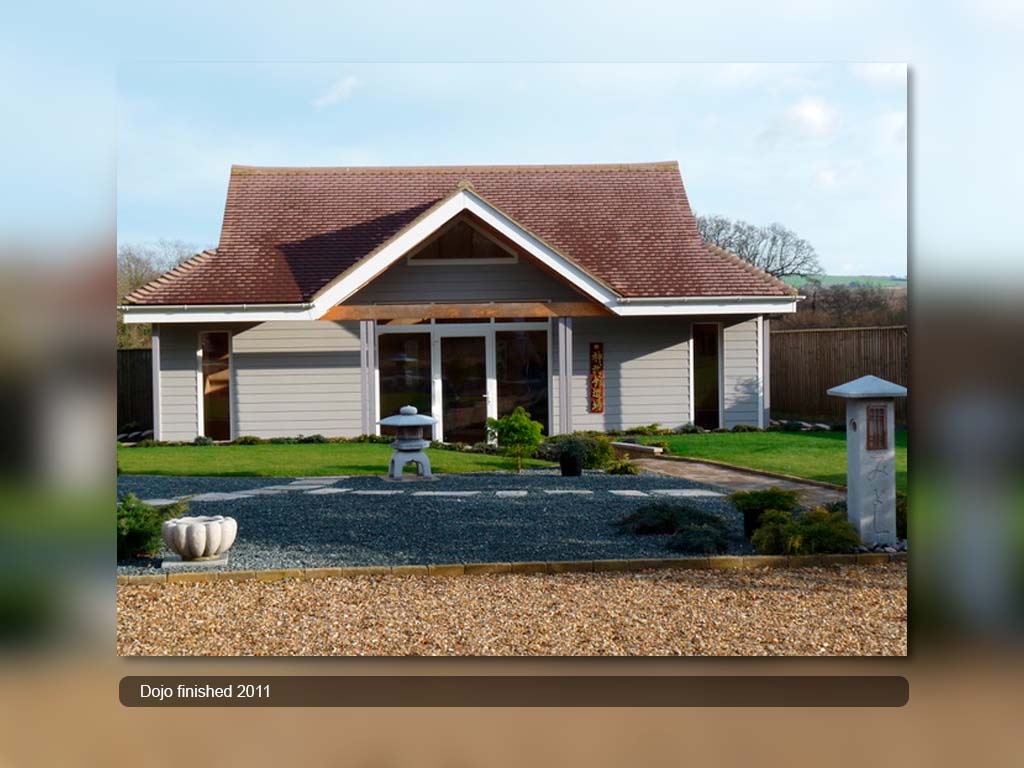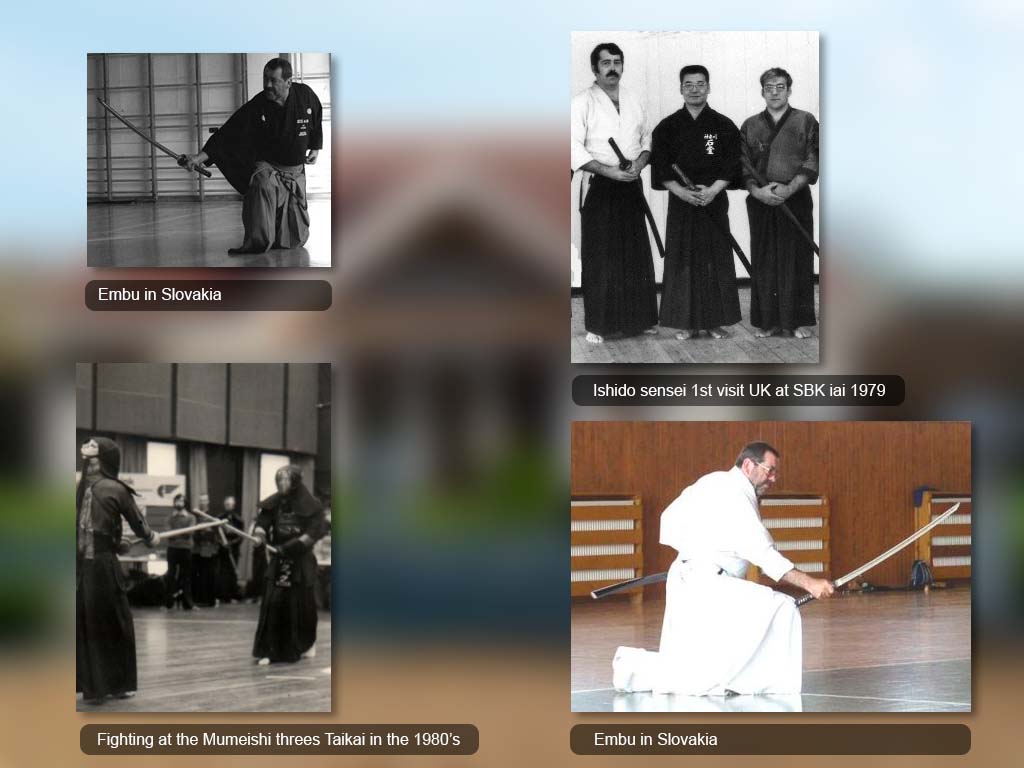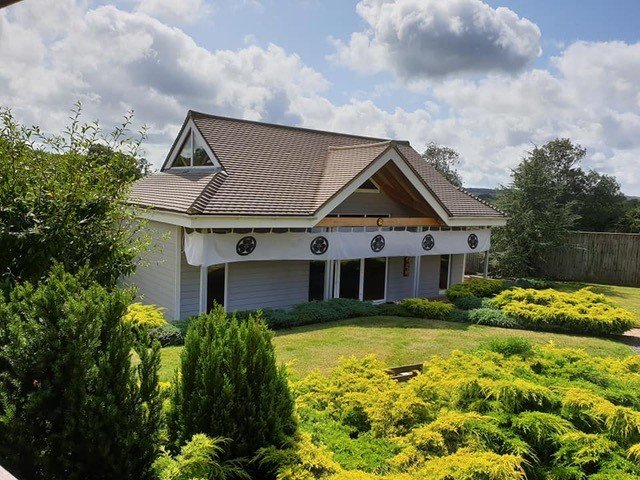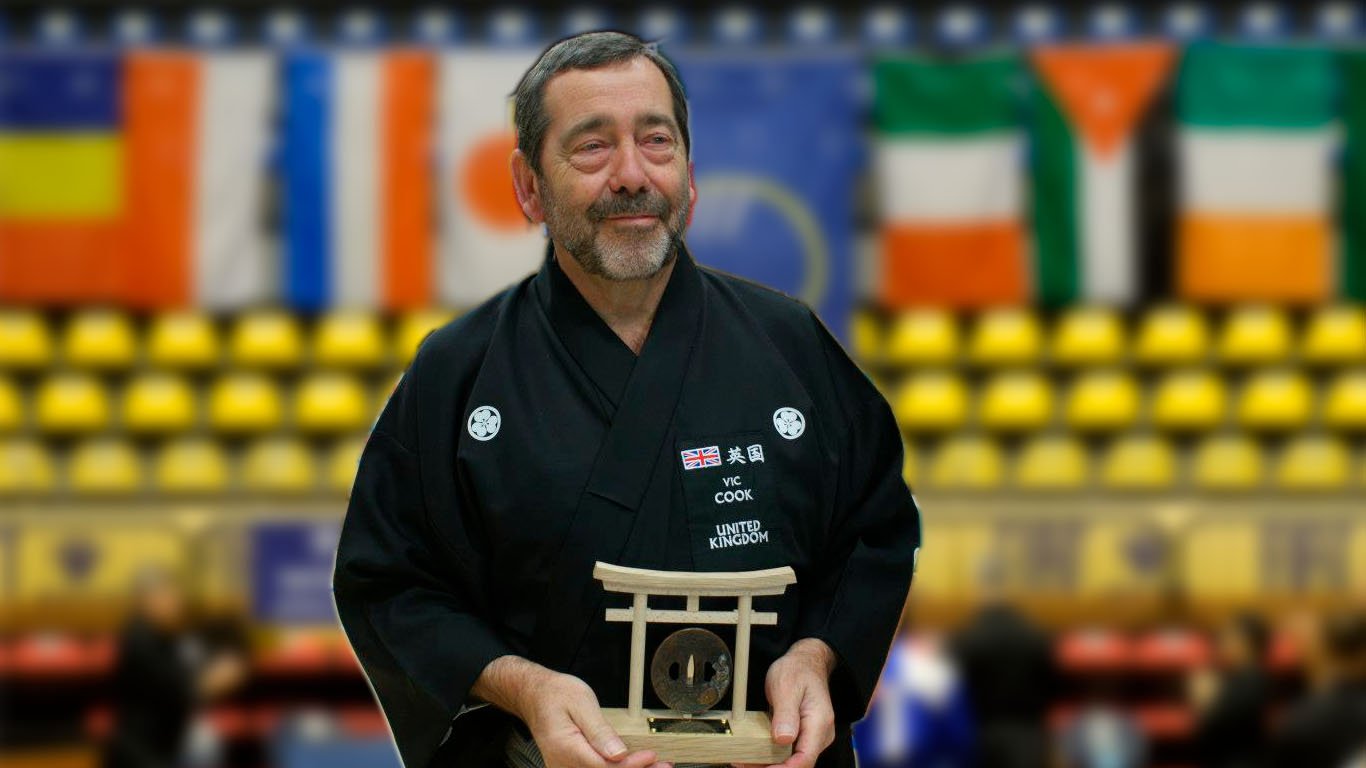Versione Italiana qui
Between history and evolution, through the interviews dedicated to the historical figures of Budo, we present another great protagonist of European Budo. With his accolades at home and abroad he has contributed enormously to the development and growth of the sword arts with a career that began in 1962: practitioner, national competitive athlete, coach, organizer, international referee, Victor Charles Cook, Kendo, Iaido and Jodo practitioner, tells us his story.
Cook Sensei, thank you for having accepted our proposal with kindness and availability in order to get to know you better and to be able to illustrate to our readers the story behind a prominent figure of Budo like you.
Let’s start immediately with some personal details: when and where were you born?
Born in Gosport, Hampshire on 08/06/1943 close to the Portsmouth Naval base.
I do feel like you had a very long career in Budo, and your cv can simply confirm this all. But please tell us how and when this all started. What are your dan grades and how did you realise Budo was a life commitment to you?
In 1962 I was sent to the London College of print by my company, to study graphics and the technical aspects of Typography and printing when I met R.M.Knutson who asked if I would be interested in practising Kendo. The classes were held at the London Judo Society and this is where I first met Jock Hopson Sensei.
Some 20 years later I managed to injure myself using bad ergonomics using a computer for hours at a time when I managed to slip a Disc under the seventh vertebrae which eventually caused a neurosurgeon to advise me strongly to stop practising kendo or he would have to fuse the vertebrae together, something I didn’t fancy. It was then that I concentrated myself on Iaido & Jodo where one can control one’s practise, this is where I came to the self-understanding that I couldn’t and wouldn’t let go of the practising of Budo. Grades that I managed to achieve in Budo are – Iaido Nanadan Kyoshi, Jodo Godan and Kendo Yondan.

I’m sorry to learn about the injury, and if I can dare, it is still a positive example of dedication and perseverance, demonstrating how many and what results can be achieved with constant practice. But when it started I imagine the situation was very different from the current one: what was the typical scenario of the Iaido dojo in your beginner times?
There were no specific dojo for the practice of Iai in the UK, however several leading members of the BKA were occasionally practising as best they could from the occasional visiting Japanese Kendo sensei. Of course, individuals such as Hopson Sensei managed to encounter teachers such as Ishido Sensei while residing in Japan. However, on Ishido Sensei’s first visit to England we experienced several sessions which I found somewhat exciting, but hell for my knees but having witnessed Sensei’s demonstrations I realised that whatever Iai I had observed in the past wasn’t what I had witnessed on Sensei’s visit.
I do love hearing about such pioneering stories, they really offer a great view about the huge accomplishments Sensei like you have achieved starting when almost nothing really existed. Remaining I your early times, who is your Sensei, what Ryu ha do, how did you get in contact with him?
My Sensei is Ishido Shizufumi Hachi Dan Hanshi.
I received a call from Japan in the early Summer of 1979 from Hopson Sensei asking whether I could or would give bed and Board to a young Iai Sensei who wanted to visit England in August and investigate the amount of interest in Iaido in the UK. As my Dojo in Brighton was one of a few that were open during the August holiday period and having agreed to look after him the die was cast as it were. When Sensei first visited my dojo, he noticed that hanging on the wall was the kanji for the Shin Bu Kan which he thought was my dojo honouring his coming to the UK. It was somewhat difficult to explain that the Kanji was the name of my dojo………Karma!

I can only imagine the situation and the diplomatic embarrassment, perhaps even amplified by different cultures. But after this first approach, how did the relationship with your Sensei begin and how did it evolve?
It’s a strange feeling for me personally – in the first instance I fully respect him as my Iai teacher as he held nothing back concerning his knowledge of budo and because of his patience and friendliness. There came a time when I was very fortunate to have his full support at a time when my personal life needed help without having to ask when I needed a true friend, he gave of himself his support and generosity of spirit at the right time when needed. His actions formed with me a strong feeling of friendship and gratitude.
So, thanks to this deep friendship I imagine you visited him in Japan. When did you happen to go to Japan the first time? I also assume those early days might have offered mixed feeling about being a foreigner in their dojo. Is there any memorable experience you would like to share? Do you still regularly train in Japan?
In 1981 I was fortunate enough to be included in a three-week invitation to Japan with Jock Hopson Sensei to further our study of Iai at Ishido sensei’s Dojo, because of my career and family commitments I never had the time to entertain block courses in Japan to study but have travelled back and forth for various events and of course having taken personal grading examinations, which usually took three to four weeks training each time. During one of these visits, I asked Sensei if he could guide me to a retailer who could supply me with Mon transfers and such, for use in my dojo from a design I had taken from a Monsho book. Try as we might, there was no luck as the design I’d shown existed but very rarely used. That evening, Ishido sensei’s father entered the dojo and presented me with permission as I was a personal student of his son, the right to wear and use the family mon. An incredible honour that I never expected.
As far as any feeling of grievance being felt by one’s hosts, I must admit that I didn’t sense it at all. There was one memorable experience though not intended, was when I requested through Sensei an appointment at the local barbers as after three weeks without shaving or trimming a full beard it needed some fixing.
On the big day It caused somewhat of a stir observing a gaijin having his facial hair plus ear, nose and brow hair shaved off with a cutthroat razor, it must have been the highlight of their week’s entertainment.

I understand that the relationship with your Sensei is very solid and long-standing. Therefore, you must have been able to learn a lot about teaching methods: what is, in your opinion, the difference between Japanese teaching (as your Sensei’s towards you) and the Western one (as yours towards your students)?
The short answer is no difference whatsoever. My experience in starting under Ishido Sensei’s tutorship was his patience first and foremost, there were no shouting or bluster, no drill instructor type shouting or laughing or clever snide remarks aimed at the individual, this raises fear levels in the student which destroys self-confidence and enjoyment.
I personally explain to all assistant instructors – never forget that you were once a beginner don’t bully or be-little people it achieves nothing.
When did you think about teaching and when did you start teaching? Is there any preference of yours about, toward a specific class, their unique requirements (kids, competitors, adults) and the teaching you are delivering?
For myself there wasn’t an option but to teach others if I wanted to carry on practising. As I was recalled home from London by my company and as I was completely absorbed into kendo by this time it was a situation of finding other people who would be interested in starting a dojo. In 1963 there were very few people who knew that Kendo existed let alone practising it in the UK. It was a case of searching for membership who would be as mad as myself. Advertising in a national Judo magazine at the time raised several students who launched the first club, the rest as they say is history.
I remembered at the time when I first confronted a class, there was a maxim that I had absorbed which was – (Teach what you most need to learn). That is what set me on the path of being a teacher as a mere shodan!
As far as how one prepares to teach, I tend to use my instincts, but keeping to basics is something not to sneer at as correct repetition cannot be beaten if you want one’s technique to improve. It is rare for me to have ever faced a children’s class and those rare moments when I did, it was soon obvious to me that one must keep children entertained as their concentration span is relatively short, but it can be fun.
As far as adults are concerned, I always approach the situation in treating beginners and established students with equal respect and patience, whether they are young and strong and eager for competition, in which I voice the adage –”. If you wish to be on the winner’s rostrum, “You can only compete the way you practise”. For the average individual or middle-aged student searching for just a hobby, encourage the student of any age whatever they do should be enjoyable, it would be pointless both to the student and the teacher if they didn’t.

Those maxims are so acute and deep, transitioning one’s own training and discipline across the boundaries of the relationship between teacher and student, a matter of reciprocal influence to improve together. Improvement of one’s self and practice that have to step through how they contribute all together to the individual formation. How do you think Kendo, Iaido and Jodo and their cross relation influenced your overall budo development?
As all three disciplines contain how to use the sword it obviously gives insight of how the sword must be used against different situations, how practitioners of just a single discipline can fully understand swordsmanship is beyond me. Therefore, my own career, such as it is, has given me a better understanding of budo.
And along with a better understanding should also come realising how Iaido has changed through the years hasn’t it?
Of course, it’s changed, it’s constantly under development, one has only to look at vintage film clips of the Dai sensei 50/60 years ago. I doubt that if the way some embu’s were then demonstrated, they would have difficulty in Passing 3rd or 4th dan by today’s judging standards. I believe personally that Iaido has become more and more aesthetical and technical, leaving the sense of Budo adrift, so that one finds it difficult to feel any sense of danger that the practitioner is threatened with.

So the teaching itself has probably changed: going back again to this theme, how does our typical Iaido lesson take place?
Firstly, it’s a case of warming up the body with suitable exercises followed by cutting techniques, chiburi, Noto and various repetition exercises. I usually then lead the class in Seitei Iai at least three times to generally warm up overall. Then it’s a case of picking on one of the Seitei kata to thoroughly dissect and explain the major points of its construction and what judges are looking for. I follow this by encouraging free practice or Koryu and finishing by warming down and perhaps question & answer if time allows.
You mentioned the difference between aesthetics and technique on one side and Budo on the other. Do you think non-Japanese student can truly understand the culture and philosophy behind Iaido?
To be honest it depends entirely on the individual, some people go and live in Japan, learn the language, and generally meld into what is a different society. Even then with some individuals I’ve met they obviously cherry picked what they liked and ignored everything else and yet claim they understand the Japanese mind. Other people I’ve met have obviously absorbed themselves as much as they can and truly believe that they have an inkling on what makes Japan tick but admit that they have only scratched the surface. In short, I personally think that I’m not Japanese and never will be, but I try to absorb their culture as best I can.

Between culture and development, how do you see the future of European Iaido?
If we follow the Japanese Teachers and allow them to give us guidance, I think we have a chance to catch up somewhat in both technique and Budo understanding.
What I fear most is that now we have a good number of 7th Dans and some with the attitude of “we don’t need the Japanese anymore”. I have seen this in Karate, Judo, Aikido and other Japanese disciplines.
I once asked a self-graded senior Karateka! why he didn’t invite a Japanese teacher for his association seminars – His answer was “all they want to do is go back to fundamentals that’s boring” plus I get all the fees by not having to pay their expenses. I very much hope that traditional skills will not dissipate, and so-called egotistical and mediocre professionalism doesn’t take over.
So apparently a cross-discipline attitude that might ruin future classes of teachers and students. But we have a lot of exceptional examples like yours to follow: what is then a budo teaching you particularly like transmitting?
Humility! When my father advised me some years ago when I was a teenager in the 50s – “That no matter how good or skilled you may get in whatever subject you achieve, never forget that there always will be someone better than you”.

As usal, time flies when one lingers with something pleasant. Your enlightening words and maxims anchor us to the terrain of continuous improvement and for the creation of the best foundations on which to build the future of our disciplines, not only on the technical side. You also talked about the pleasure of practicing and having fun, and it is our custom to end these chats by delving into the less serious memories of the history of European budo. Is there any funny anecdote about Iaido that you like to remember?
Apart from the usual observations of beginners trying to dress themselves in hakama and managing to get two legs in one side of the trouser etc. I recall sometime in the past when on a summer’s day at a seminar, a friendly Taikai was organised. As it was quite warm the doors of the dojo were left open which was an invitation for a squadron of wasps entering the fray – it was the desperate attempts by a referee trying to look calm and composed studying the combatants but failing miserably by using his flags swatting at the insects buzzing around his head.

Victor Charles Cook Shortened Budo CV
KENDO
Commenced Kendo studies September in London 1962
Awarded 4th dan Kendo ZNKR 1981 Berlin European Kendo Championships
Won the Japan Airlines Cup on 3 occasions and Runner up twice between 1968 – 1974
Won the Sir Frank Bowden Taikai 1970
Represented Great Britain in Kendo European Championships Berlin 1981
Retired from kendo 1985 due to upper spinal injury in the workplace.
IAIDO
Recommenced studying Muso Shinden Ryu Iai under Ishido Shizufumi Hachidan Hanshi in 1979
Awarded Renshi by the Zen Nippon Kendo Renmei 1996
Awarded Nanadan ZNKR 1999 Tokyo
Elected as executive officer to Iai Bu 1986-98
Elected to the post of Iaido Bucho 1998 – 2010
Appointed as GB Iaido squad manager and Coach 1997 – 2001
(During this period the team achieved bronze, silver and gold medals)
Organised all BKA seminars and grading since 1998 to 2010
Organised 7th European Iaido Championships 1999 at Sussex University
Appointed as International Referee and Grading Panellist 1986
Has been a principal teacher at the BKA Spring seminar since 1998.
Has been principal organiser for The BKA National Iaido/Jodo Taikai 1998 – 2010
Appointed as Referee & Juror to all European Iaido Championships since inception of the competition except Sweden 2004.
Retired as referee after 2013 European Iai Championships Meze France at the age of 70
JODO
Commenced the study of Muso Ryu Jodo under Hiroi Sensei Kudan Hanshi/ Ishido Sensei 1981
Elected and held the post of Jodo Bucho 1983-86
Awarded Godan 1996 Amsterdam
Appointed as International Referee and grading panellist 1996
1st place 3rd Dan National Taikai at BKA Summer seminar Ipswich 1986
1st place 5th Dan Taikai at BKA Summer seminar Warwick 1997
DEVELOPMENT OF BUDO IN BRITAIN
Founded Portsmouth Kendo Dojo in 1963 (Now Shin Bu Kan Portsmouth)
Founded Dojo in Liverpool 1965 also in Llangollen North Wales 1967.
Founded the Shin Bu Kan Dojo in Brighton 1977 also through personal students have founded Dojo in Rochester, Guildford and Southampton.
INTERNATIONAL BUDO DEVELOPMENT
Have been invited to teach, grade and referee in South Africa, Italy, Holland. France, Germany, Hungary, Poland, Slovakia & Czech Republic.
Was requested to help on a regular basis to develop Iaido and Jodo for the Czech Republic in 1995, since then have visited both countries at least once a year.
Awarded honorary life membership in 2001 by the Czech Kendo Federation for services to the development of Iaido and Jodo to the Czech Republic.
Awarded honorary life membership to the Slovak Kendo Federation in 2000, for services given in the development of Iaido and Jodo to the Slovak Republic.
Was requested to help develop Iaido and introduce Jodo by the Hungarian Kendo Federation through the offices of Abe Sensei and Ishido Sensei in 1999 and have visited Hungary regularly since. Until Covid












